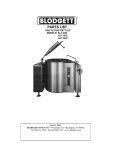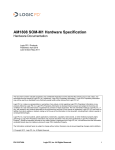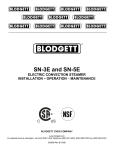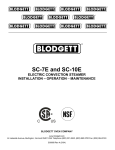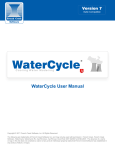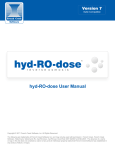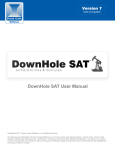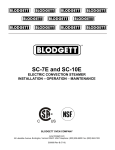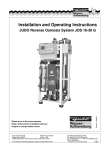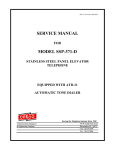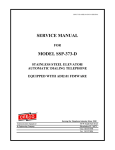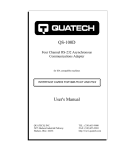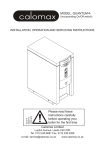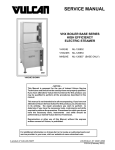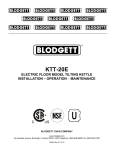Download Blodgett KLT-DS User's Manual
Transcript
KLT-DS and KPT-DS Series DIRECT STEAM TRI-LEG TILTING KETTLE AND DIRECT STEAM PEDESTAL TILTING KETTLE INSTALLATION – OPERATION – MAINTENANCE BLODGETT OVEN COMPANY www.blodgett.com 44 Lakeside Avenue, Burlington, Vermont 05401 USA Telephone (800) 331-5842, (802) 860-3700 Fax: (802) 864-0183 1 B (6/06) S00057 Rev IMPORTANT NOTES FOR INSTALLATION AND OPERATION It is recommended that this manual be read thoroughly and that all instructions be followed carefully. This is the safety alert symbol. It is used to alert you to potential personal injury hazards. Obey all safety messages that follow this symbol to avoid possible injury or death. WARNING: Improper installation, operation, adjustment, alteration, service or maintenance can cause property damage, injury or death. Read the installation, operating and maintenance instructions thoroughly before installing, operating or servicing this equipment. Intended for commercial use only. Not for household use. NOTICE: Contact the factory, the factory representative or local service company to perform maintenance and repairs. This manual should be retained for future reference. 2 TABLE OF CONTENTS DESCRIPTION PAGE INSTALLATION AND SERVICE CONNECTIONS – KLT-DS ............................................ 4 INSTALLATION AND SERVICE CONNECTIONS – KPT-DS ............................................ 5 1.0 INSTALLATION INSTRUCTIONS .............................................................................. 6 2.0 INTRODUCTION - DESCRIPTION ............................................................................ 7 3.0 BASIC FUNCTIONING .............................................................................................. 7 4.0 OPERATING INSTRUCTIONS .................................................................................. 8 5.0 CLEANING INSTRUCTIONS ..................................................................................... 8 6.0 TROUBLESHOOTING MAINTENANCE .................................................................. 11 3 SERVICE CONNECTIONS – KLT-DS S STEAM SUPPLY: 3/4"IPS 5-30 PSI (34-205 kPa). OPTIONAL 5-45 PSI (34-310 KPa) HOT WATER: 3/8” O.D. TUBING TO FAUCET (OPTIONAL) COLD WATER: 3/8” O.D. TUBING TO FAUCET (OPTIONAL) CONDENSATE RETURN: 1/2"IPS DIMENSIONS MODEL CAPACITY 20 gallons 76 litres 30 gallons KLT-30DS 114 litres KLT-40DS 40 gallons 152 litres KLT-60DS 60 gallons 227 litres 80 gallons KLT-80DS 303 litres 100 gallons KLT-100DS 379 litres UNITS inches mm inches mm inches mm inches mm inches mm inches mm KLT-20DS A 21 535 24 610 26 660 29.5 750 33 840 35.5 902 B 18 460 20 510 22.5 570 26 660 28 710 30 762 C 37 940 37 940 37 940 40.5 1029 42.5 1080 42.5 1080 D 34.75 885 37.75 960 39.75 1010 43.25 1100 46.75 1185 49.25 1251 E 28.5 724 31.5 800 33.5 850 37 940 40.5 1030 43 1092 F 22 559 20.75 527 20.25 514 21.5 546 20 508 21 533 G H(2") 25.63 12 651 305 27.13 12.5 689 317 28.63 13 727 330 30.13 15.5 765 394 32.63 14.5 828 368 39.25 18 997 457 H(3") 13.25 337 14.25 362 15.25 387 15.5 394 16.25 413 20.25 514 J(2") 17 432 15 381 12.5 318 14.5 368 12.5 318 10.5 267 J(3") 16.5 419 14.5 368 12 305 14 356 12 305 10 254 K 59.5 1512 62.5 1588 64 1626 74 1879 76 1930 79 2007 L M 15.38 391 15.38 391 16.38 416 18.38 467 19.88 505 21.5 546 9.5 241 11 279 12.5 318 * Pressure reducing valve is required if incoming pressure exceeds 50 PSI (345 kPa). DIMENSIONS ARE IN INCHES [MM] SAFETY RELIEF VALVE STRAINER AND STEAM TRAP (OPTIONAL) L L NOTE: 60 , 80 & 100 gallon kettles are supplied with 2 rear support legs 45° 1.63 (41) ØA 2" VALVE: CLOSED 5.13[130] OPENED 6.88[175] S FLANGED FOOT DETAIL 4 EQUALLY SPACED Ø7/16" [11mm] HOLES ON 3 [76] B.C. 3” VALVE CLOSED 7.88[200] OPENED 10.13 [257] SPRING ASSISTED COVER - OPTIONAL FAUCET (OPTIONAL) M 70° B K 2" or 3" TANGENT DRAW OFF VALVE (OPTIONAL) J F C S JACKET DRAIN VALVE E D G 4 H SERVICE CONNECTIONS – KPT-DS S STEAM SUPPLY: 3/4" IPS (19MM) 35 psi (2.4 KG/CM2) CONDENSATE RETURN: ½" IPS (13mm) DIMENSIONS MODEL CAPACITY 20 gallons 76 litres 30 gallons 114 litres 40 gallons 152 litres 60 gallons 227 litres 80 gallons 303 litres KPT-20DS KPT-30DS KPT-40DS KPT-60DS KPT-80DS UNITS inches mm inches mm inches mm inches mm inches mm A 21 535 24 610 26 660 29.5 750 33 840 B 18 460 20 510 22.5 570 26 660 28 710 37.75 959 39.75 1010 43 1092 46.5 1181 E F 14.75 20 375 508 16.25 21.5 413 546 17.25 22.5 438 572 18.87 479 20.63 25.88 524 657 G 13.5 343 14 356 15.5 394 17.5 445 19 1483 H 41 1041 43 1092 45 1143 48 1219 52 1321 J 15.25 387 13.25 337 10.75 273 10.25 260 9.75 248 K 20.5 521 20 508 18.5 470 19.25 489 20.5 521 L 59.5 1511 62.5 1587 64 1626 74 1879 76 1930 FAUCET (OPTIONAL) L ° 2 [51] 70 : 3” VALVE .88[200] 7 D E N E P ] O 10.13[257 D E S O CL C B 2"or 3" TANGENT DRAW OFF VALVE (OPTIONAL) S POUR PATH K A 7.38 [187] 4 [102] M E N(3”) 16.25 413 14.25 362 11.75 298 13.75 349 11.75 298 6.25 [159] : 2" VALVE .13[130] 5 D E N E P O ] 6.88[175 D E S CLO SPRING ASSIST HINGED COVER (OPTIONAL) JACKET DRAIN VALVE 17.5 445 17.5 445 17.5 445 20.5 521 N(2”) 16.25 425 14.75 375 12.25 311 14.25 362 12.25 311 4X Ø7/16 [11] EQ. SPACED ON 16.62 [422] B.C. (20 TO 60 GALLONS) ON 19.62 [498] B.C. (80 GALLONS) VIEW A-A A M S ØA STEAM TRAP AND STRAINER (OPTIONAL) D DIMENSIONS ARE IN INCHES [MM] 45° SAFETY RELIEF VALVE C 37 940 37 940 37 940 40.5 1029 42.5 1080 F D 5 G H 1.0 INSTALLATION INSTRUCTIONS 1. Select a location to provide drainage for kettle pour path when tilted and for draw-off valve if so equipped. 2. Mark hole locations through flanged adjustable feet on KLT-DS models and through pedestal base on KPT-DS models. Remove kettle. 3. On hole locations marked, drill holes and insert expansion shields to accommodate 5/16" size lag bolts. 4. Reposition kettle. On KLT-DS models level kettle by making necessary adjustment on flanged foot. 5. Bolt down kettle and seal with Silastic or other equivalent sealing compound. Sealant must be applied not only to bolt heads but also around flanges or pedestal base making contact with floor surface to fulfil NSF requirements. 6. Connect steam line (3/4" pipe size) to the kettle, making sure there is a steam control valve strainer fairly convenient to the kettle. 7. Connect kettle condensate return line to a drain or to a boiler return line. Each kettle return line must have a suitable steam trap. Boiler return lines must have a check valve. 8. Safety relief valve on kettle must not be plugged as it is set to relieve excess pressure in the kettle. 9. If incoming steam pressure is greater than kettle maximum operation pressure then a pressure reducing valve must be installed in the line. 10. If large amounts of water accumulate in the steam line it will be necessary to install one or more ball float traps in the line to eliminate the water. 11. A steam line pressure gauge is also recommended to determine the actual amount of steam coming to the kettle. 12. Check for proper operation. 6 INTRODUCTION 2.0 DESCRIPTION All Blodgett direct connected steam jacketed kettles pertaining to this manual are direct steam operated pressure vessels of a double-wall stainless steel construction forming a steam chamber (jacket) enveloping the lower two thirds of the kettle bowl surface. All kettles are tilting, floor mounted in fixed positions either on legs with adjustable flanged feet (KLT-DS models) or pedestals (KPT-DS models). All kettles are equipped with a drain cock, safety relief valve and a steam control valve. Options on kettles are hinged spring assisted stainless steel lid covering the kettle bowl opening and a sanitary stainless steel tangent draw-off valve as an alternate method for the removal of the food product from the kettle bowl. 3.0 BASIC FUNCTIONING 3.1 CAPACITIES All model names contain either - 20, - 30, - 40, - 60, - 80 or - 100 to indicate the capacity of that kettle in U.S. gallons. Thus a KLT-40DS is a two thirds jacketed direct steam kettle mounted on legs with a capacity of 40 gallons (U.S ). 3.2 FUNCTIONING MODE Blodgett direct connected steam jacketed kettles consist of a stainless steel bowl and a stainless steel jacket which envelopes two thirds of the lower surface of the bowl thus forming a sealed pressure vessel (chamber) into which steam is introduced by means of a manual control valve. The kettle bowl is the container for the food product which ideally should be of a liquid or semiliquid consistency to achieve complete contact with the bowl surface and thus fully absorb the heat transmitted through the surface. The temperature required for the cooking process to function adequately must be greater than the boiling point of the liquid food product, ie. water. Further, the greater the steam pressure used, the higher the temperature and consequently the quicker the cooking process. For example, steam pressurized at 30 p.s.i. attains a temperature of 274 degrees Fahrenheit (135 degrees Celsius). 7 4.0 OPERATING INSTRUCTIONS 1. If kettle has draw-off valve, close it. 2. Fill kettle with product to desired level. 3. Slowly turn the steam control valve ON to full open position (counter clockwise). 4. The water or food should boil 2 to 3 gallons per minute. If it does not then incoming pressure and piping should be checked to determine that it is adequate to operate the kettle efficiently. 5. Regulate steam control valve depending on type of food being prepared. 6. When food is cooked, turn off steam, remove food and clean kettle immediately to prevent residue from drying on kettle bowl surface. 5.0 CLEANING INSTRUCTIONS CAUTION: Do not use cleaning agents that are corrosive. CAUTION: The equipment and its parts are hot. Use care when operating, cleaning and servicing. Your kettle should be cleaned immediately after each use or when cooking a different product. Before cleaning, check that the kettle has cooled enough to touch it. 1. Rinse the inside of the kettle thoroughly and drain to remove any food particles. 2. Using a nylon brush, clean the kettle with a mild detergent and water. Never use steel wool or scouring powder as it will scratch stainless steel. Plain steel wool can leave small pieces of steel which can rust. 3. Rinse the inside of the kettle thoroughly with clean water. Drain the kettle by tilting or using the optional tangent draw-off valve to allow the detergent and water solution to drain. 4. Wipe the exterior of the kettle with a clean, damp cloth. WARNING: If your are cleaning a valve that is assembled to a kettle, be sure the kettle is completely empty of any product. 8 DRAW-OFF VALVE CLEANING 1. If equipped with a tangent draw-off valve, turn the large hex nut on the draw-off valve counterclockwise until it is completely disengaged from the threads. Grasp the valve knob and slowly pull out the valve stem. Wash the valve stem, disk and handle. Insert a nylon brush, wet with detergent and water, into the valve body and tangent draw-off tube. Brush vigorously. 2. Replace the valve stem assembly and turn the hex nut until snug. Rinse the kettle with clean warm water. 3. Leave the draw-off valve open when the kettle is not in use. DAIRY DRAW-OFF VALVE CLEANING 1. Remove the plug by first removing the handle, then turn the plug to line up with the pin and pull with both hands. It is important to use both hands because the plug is heavy. 2. Put the plug in a plastic pail that contains a mild soap solution. A plastic pail works best, as it reduces the possibility of nicking or scratching the plug. If the plug gets scratched it may not seal correctly and could leak. 3. Use a soft cloth or soft brush and clean all surfaces. 4. Using both hands remove the valve from the soap and rinse well in another plastic pail that contains fresh water. 5. Wash out the kettle as normal. 6. Return the plug into the body. Be sure the plug is inserted into the notch and turned. Ensure the plug is tight and secure before letting go of it. If you are cleaning a body and plug assembly, remove the plug and follow the above procedures. when finished with the plug, follow the same instructions for washing the body. Always use both hands when handling the plugs. Reassemble the plug into the body and use as normal. WHAT TO DO IF SURFACE RUST APPEARS Metal utensils should never be used as they will scratch the surface of the equipment and rust may begin to form. To remove surface accumulation of rust from the inadvertent use of such utensils, the following procedure may be used. CAUTION: Improper use of this procedure may damage your appliance! 1. Use undiluted white vinegar with a non-abrasive scouring pad (plastic) or cloth on the affected area to remove the rust stain. The appliance should not be heated and remain at room temperature during the entire cleaning process. 9 2. If the stain resists removal, additional exposure time with vinegar may be required, to a maximum of one hour. 3. Thoroughly wash all of the vinegar away with fresh clear water. Dry the surface completely and allow one hour before using the appliance to cook. Following daily and period maintenance procedures will prolong the life for your equipment. Climatic conditions - salt air - may require more thorough and frequent cleaning or the life of the equipment could be adversely affected. STAINLESS STEEL To remove normal dirt, grease or product residue from stainless steel, use ordinary soap and water (with or without detergent) applied with a sponge or cloth. Dry thoroughly with a clean cloth. Never use vinegar or any other corrosive cleaner. To remove grease and food splatters or condensed vapours that have baked on the equipment, apply cleanser to a damp cloth or sponge and rub cleanser on the metal in the direction of the polishing lines. Rubbing cleanser as gently as possible in the direction of the polished lines will not mar the finish of the stainless steel. NEVER RUB WITH A CIRCULAR MOTION. Soil and burn deposits which do not respond to the above procedure can usually be removed by rubbing the surface with SCOTCH-BRITE™ scouring pads or STAINLESS scouring pads. DO NOT USE ORDINARY STEEL WOOL as any particles left on the surface will rust and further spoil the appearance of the finish. NEVER USE A WIRE BRUSH, STEEL SCOURING PADS (EXCEPT STAINLESS), SCRAPER, FILE OR OTHER STEEL TOOLS. Surfaces which are marred collect dirt more rapidly and become more difficult to clean. Marring also increases the possibility of corrosive attack. Refinishing may then be required. TO REMOVE HEAT TINT: Darkened areas sometimes appear on stainless steel surfaces where the area has been subjected to excessive heat. These darkened areas are caused by thickening of the protective surface of the stainless steel and is not harmful. Heat tint can normally be removed by the foregoing, but tint which does not respond to this procedure calls for a vigorous scouring in the direction of the polish lines using SCOTCH-BRITE™ scouring pads or a STAINLESS scouring pad in combination with a powdered cleanser. Heat tint action may be lessened by not applying or by reducing heat to equipment during slack periods. All food contact surfaces must be thoroughly drained and flushed prior to cooking in the kettle. CONTROL PANEL: The textured control panel should be cleaned with warm water and mild soap. Never use an abrasive cloth or steel wool. Never use cleaning solvents with a hydrocarbon base 10 6.0 TROUBLESHOOTING MAINTENANCE 6.1 PREVENTIVE MAINTENANCE No preventive maintenance is required other than adhering to the Cleaning Procedure instructions. 6.2 DRAW-OFF VALVE LEAKS If a leak occurs through the valve steam, replace the “O” ring. If the leak can be attributed to faulty sealing occurring between the stem disc and valve seat, then quite often this problem can be corrected by cleaning off the dried on food residue with an extremely fine emery cloth or the rubber vulcanized stem piece has been damaged and must be replaced. NOTICE: Draw-off valve has a vulcanized rubber coated stem for better sealing. Do not over tighten. This may cause the rubber to pull away from stem and permanently damage it. 6.3 EXTREMELY SLOW COOKING TIME If the cooking time is abnormally slow then the difficulty may be due to insufficient steam pressure and/or volume. First determine that pressure on incoming steam line at kettle is within 5 p.s.i. of rated kettle pressure. Note that pressures approaching the rated kettle pressure are liable to set off the safety relief valve. If required pressure is available to kettle, then possibly volume of steam is not sufficient. Minimum 3/4" pipe size is required to the kettle but if the steam generating source is at a great distance from the kettle, larger pipe will be required. Finally, the core of the steam supply pipe may have debris or scalants that impede steam flow and will require disassembly and inspection. 6.4 AIR VENTING It is recommended that the “optional” steam trap assembly be installed. This should be plumbed to the exit end of the kettle. The thermostatic trap is a mechanical device that closes on high temperature and opens when the temperature drops, allowing the water which formed from condensate to exhaust but retain the steam under pressure. The temperatures required for the cooking process to function adequately must be greater than the boiling point of the liquid food product, that is, water. The greater the steam pressure used, the higher the temperature and the quicker the cooking process. For example, steam pressurized at 30 p.s.i. reaches a temperature of 274 degrees Fahrenheit (135 degrees Celsius). Since air is an unsuitable media through which heat may be transferred, the air should be exhausted from the jacket by opening the pressure relief valve until the air has been completely replaced by pressurized steam. In the initial stages of the cooking process when the steam comes in contact with the cold kettle bowl surface, it condenses and forms a large amount of water. The condensate water must be removed from the kettle jacket in order for the kettle to function adequately. The ball valve located at the base of the kettle jacket may be opened to remove the water. It may be necessary to repeat this procedure several times depending on the number of batches being cooked as each batch will create condensate. If the kettle appears to be slow in heating, this would indicate 11 that there is water in the jacket. Open ball valve and drain. Close valve and commence operation of kettle. 12












